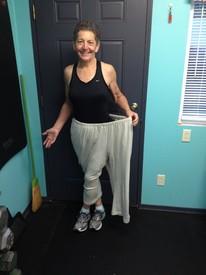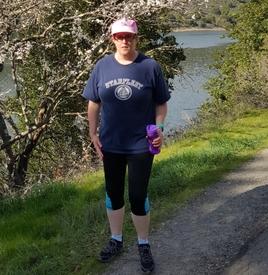Walking and Shin Splints

tonisha1821
Posts: 24 Member
I've been trying to become more active. I have a treadmill, but I get shin splints. Walking on a treadmill at 3.5 mph and a 3% incline, my heart rate gets up to 170 and I can guarantee that in 5 minutes, my shins will feel like they're about to snap in half, sometimes, even if I'm wearing compression sleeves. At 2.5 mph and a 3% incline, my heart rate gets up to 160 (yeah, I'm that out of shape) and I can walk for 20 minutes without getting shin splints, without my compression sleeves.
I have tried taking aspirin before a work out, an apple, a banana, and 3 cups of water before getting on the treadmill, and after all of that, even with compression sleeves, my shins still hurt so bad and my calves cramp up.
My question is what should I do? Are there any remedies you know of to relieve shin splints? Should I just walk through the pain? Should I just walk at 2.5 mph and gradually increase the speed as I regain muscle in my legs? Please help me
I have tried taking aspirin before a work out, an apple, a banana, and 3 cups of water before getting on the treadmill, and after all of that, even with compression sleeves, my shins still hurt so bad and my calves cramp up.
My question is what should I do? Are there any remedies you know of to relieve shin splints? Should I just walk through the pain? Should I just walk at 2.5 mph and gradually increase the speed as I regain muscle in my legs? Please help me
0
Replies
-
Land on the pad of your foot instead of the heel (yeah it's gonna feel REALLY weird at first), and the shin splints will never appear.
If your feet start to hurt (arches, etc) then stop before you injure a different part of your body. It takes time to build up, but shin splints will become a faraway dream.0 -
There are stretches that helped me. I would not change the way you walk. I no longer get them.0
-
Lose the incline....use 1% and a slow speed (2.5 mph if need be) to start with and don't increase it until you can walk 30 min or so comfortably then start increasing either the speed or the incline (but not both at the same time).
The shin splints will go away on their own after time, the usual culprit is a sudden increase in level of exercise. If you do get them ice your shins after the workout.0 -
Which shoes do you walk in (make & model)? You probably have shoes with a raised heel, which tightens the calves and overworks the shins. Try "zero heel" shoes, like Keds, Vans, skateboard shoes, etc. Also stretch your calves before walking, and a few times a day too.
 0
0 -
1) makes sure you have good shoes
2) slow down. and lose the incline. work your way up to it. I might do a small increase of speed one week and an increase incline the next. but that i based on my minimal knowledge.0 -
http://www.amazon.com/Zensah-Compression-Sleeves-Black-Medium/dp/B002U2NKM6/ref=sr_1_3?ie=UTF8&qid=1453397708&sr=8-3&keywords=shin+sleeves
i started wearing this every time i went for a run! never had any leg pain ever again!!0 -
Girl, you are singing my song here.
I get shin splints and stress fractures in both tibias when I run more than 2-3 times a week. Do not try and push yourself through shin splint pain. You will get fractures and be unable to walk much for a good 6-8 weeks, which really sucks.
I suggest you go to a running store and tell them you want a good shoe for walking. They have those there too. Let them evaluate your gait (how your foot lands) and make recommendations for shoes. Unfortunately, this means you will be paying like $100+ for shoes, but once you have great shoes that really fit you can order them on Zappos for less. I do suggest you buy the first pair at the store. One, because I honestly feel it would be wrong to get them somewhere else after using their expertise and two, because if they don't work out you can take them back.
Don't walk on an incline. It can exacerbate your issue. Don't immediately try to change your gait. It's really hard and can cause pronation (rolling of the foot) which comes with it's own set of issues.
My orthopedist told me that if I was having shin splints to stop the exercise causing it for at least 10 days before trying it again.
You can also stationary bike, lift weights, swim, and try elliptical for less weight bearing activities. On elliptical don't set a huge incline just set it low and use it as a softer way of walking.
Feel free to send me a friend request. Shin splints suck so bad.0 -
I used to get shin splints when I first started, too. Once my calf muscles got stronger (but even more so the front muscles around the shin), the problem went away. You might try stregthening those front muscles around the shin. Stand with your back to a wall and heels about 6-12 inches away from the wall. Keeping your heels on the ground, raise your toes as high as you can and hold for a second or two, then lower back down. Do 3 sets of 10-12 reps. As you get stronger, keep scooting your heels closer to the wall and raise your toes higher. Depending on your strength you might have to start with only 1 or 2 sets or fewer reps.0
-
I used to get shin splints when I first started, too. Once my calf muscles got stronger (but even more so the front muscles around the shin), the problem went away. You might try stregthening those front muscles around the shin. Stand with your back to a wall and heels about 6-12 inches away from the wall. Keeping your heels on the ground, raise your toes as high as you can and hold for a second or two, then lower back down. Do 3 sets of 10-12 reps. As you get stronger, keep scooting your heels closer to the wall and raise your toes higher. Depending on your strength you might have to start with only 1 or 2 sets or fewer reps.
^^^ this exercise with your heels up really seems to help me, and if you have the balance, even walking around on your heels for a few steps a few times a day is amazing for strengthening those little muscle around your shins... I can really feel it in ten steps or so. I also find sitting down with my legs straight out and and wrapping a workout band tightly behind my toes and then pointing them against the resistance helps.
Also the other advice above of ALWAYS wearing compression sleeves (which you mentioned you already do), taking it slow and reducing speed and incline at first, and trying to land on the pad of your foot, all seem to help me. I've been a runner for many years and never had an issue, then I got sick last year and tried to jump back in too quickly once I was better and have been fighting off shin splints ever since, so good luck and take it slow.0 -
Also foam rolling the tight or sore areas may help before and after your walk/run. Superfeet insoles may help too. Good fitting shoes always help. And shorter/quicker strides can help as you develop.0
-
Get rid of the incline, walk slower, and make sure you have good shoes, not some old worn out pair.
Shin splints are most common in beginners, if you don't injure yourself trying too hard they will go away in short time.0 -
The treadmill is an unnatural environment and you might be forcing your body into unnatural strides and positions for walking.
 You might try getting off the treadmill for a couple days and walk outside, paying attention to your posture and how you change stride naturally as you up and down hills and change speeds, etc. Then once you're back on the treadmill, try to remember how you naturally walked on hills, and how your legs and feet naturally compensated for changes in stride, then you can imitate those changes on the treadmill. 0
You might try getting off the treadmill for a couple days and walk outside, paying attention to your posture and how you change stride naturally as you up and down hills and change speeds, etc. Then once you're back on the treadmill, try to remember how you naturally walked on hills, and how your legs and feet naturally compensated for changes in stride, then you can imitate those changes on the treadmill. 0 -
ElizabethOakes2 wrote: »The treadmill is an unnatural environment and you might be forcing your body into unnatural strides and positions for walking.
 You might try getting off the treadmill for a couple days and walk outside, paying attention to your posture and how you change stride naturally as you up and down hills and change speeds, etc. Then once you're back on the treadmill, try to remember how you naturally walked on hills, and how your legs and feet naturally compensated for changes in stride, then you can imitate those changes on the treadmill.
You might try getting off the treadmill for a couple days and walk outside, paying attention to your posture and how you change stride naturally as you up and down hills and change speeds, etc. Then once you're back on the treadmill, try to remember how you naturally walked on hills, and how your legs and feet naturally compensated for changes in stride, then you can imitate those changes on the treadmill.
Yes. When walking on the treadmill your feet may be flexed-up. That could be causing your shin pain. So try to get full range of motion.0 -
Land on the pad of your foot instead of the heel (yeah it's gonna feel REALLY weird at first), and the shin splints will never appear.
If your feet start to hurt (arches, etc) then stop before you injure a different part of your body. It takes time to build up, but shin splints will become a faraway dream.
^0 -
Shin splints in runners and walkers are usually caused by one of 4 things.
1. Terrible Too's... too much, too soon. Running and Walking are largely about adaptation. Take it slow and baby steps. Reduce the incline as 3% is too high for a start.
2. Improper or worn footwear are often culprits. Rule of thumb is that Shoes should be replaced after 500-800 Km (300-500 miles). Do you have the right shoes for the job? Running shoes are for running, court shoes are for volleyball\basketball etc. A proper gait analysis should be done by someone who is trained (eg. a physio, podiatrist etc) to determine the right type of shoe for your feet (do you pronate (roll inwards), supinate (roll outwards) or are you in the neutral category? There is a right shoe out there for you and your feet.
3. Mechanical defect - Again a gait analysis will tell you if something is wrong in the way you walk and put you into the correct shoe. Similarly a gait analysis can often detect muscle imbalances which lead you to shin splints and tell you how to fix it.
4. Running on uneven surfaces. Over time your body can adapt to this, but with newer runners\walkers, it often leads to shin splints.
Walking thru the pain won't fix it and will likely make it worse. I'd recommend seeing a sports physio (not all physio's are created equal) and you can likely find one by speaking to the manager of a running store (they always seem to know who is good in the area).
On the interim, I would cut back on your mileage, pace and incline. Practice deep tissue massage on your shins (if it doesn't hurt, you aren't massaging deep enough )
)
There are a few exercises you may want to perform daily as well (i'll offer you a few).
1. Crunch up your toes and raise the ball of your foot off the floor. Walk 30 paces on the heel of your foot. Repeat 3x daily to start. This work the muscles responsible for dorsiflexion (often a source of muscle imbalance)
2. Get a small bucket of marbles. Spill them and then use your toes to pick them up and put them back in the bucket. Works the intrinsic muscles in the feet.
3. Soleus and Gastrocnemius stretches (google them) 3-4 times per day. These are the muscles of the calf.
4. Calf raises on a step. Start with 5-6 on each leg and build gradually adding 1-2 every few days.
Hope these help. If you have any questions, feel free to add me as a friend.
Cheers,0 -
1) makes sure you have good shoes
2) slow down. and lose the incline. work your way up to it. I might do a small increase of speed one week and an increase incline the next. but that i based on my minimal knowledge.
I agree. I got the worst shun splints when I decided it was okay to go from not exercising at all for almost a year to hiking major Hills for an hour a weekend. Slow it down and take away your incline for a few weeks, work on building up your time rather than speed for now until your body gets used to working.0 -
i get shin splints too
get some insoles for your feet as they will be the problem this may cost u going to a running shop to be analysed
also I found doing yoga and other stretches helped loosen me off rather than just some stretches (just a quick 5-10min yoga session before a run and after to cool down too)0 -
Thank you for your feedback everyone! Much better advise than what I found on the internet. I will try everything you all mentioned! Thank you.0
This discussion has been closed.
Categories
- All Categories
- 1.4M Health, Wellness and Goals
- 398.2K Introduce Yourself
- 44.7K Getting Started
- 261K Health and Weight Loss
- 176.4K Food and Nutrition
- 47.7K Recipes
- 233K Fitness and Exercise
- 462 Sleep, Mindfulness and Overall Wellness
- 6.5K Goal: Maintaining Weight
- 8.7K Goal: Gaining Weight and Body Building
- 153.5K Motivation and Support
- 8.4K Challenges
- 1.4K Debate Club
- 96.5K Chit-Chat
- 2.6K Fun and Games
- 4.8K MyFitnessPal Information
- 12 News and Announcements
- 21 MyFitnessPal Academy
- 1.6K Feature Suggestions and Ideas
- 3.2K MyFitnessPal Tech Support Questions















